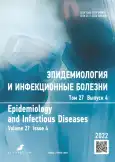Species spectrum of nonpolio enteroviruses in KhMAO–Yugra during the prepandemic and pandemic periods
- Authors: Danshina E.A.1,2, Mironov A.Y.3,4, Suranova T.G.4, Kuyarov A.V.2
-
Affiliations:
- Center for Hygiene and Epidemiology in Khanty-Mansiysk Autonomous Okrug-Yugra
- Surgut State University
- Moscow Research Institute of Epidemiology and Microbiology named after G.N. Gabrichevsky
- Academy of Postgraduate Education of the Federal Scientific and Clinical Center for Specialized Types of Medical Care and Medical Technologies
- Issue: Vol 27, No 4 (2022)
- Pages: 217-225
- Section: Original study articles
- Submitted: 08.11.2022
- Accepted: 19.12.2022
- Published: 21.01.2023
- URL: https://rjeid.com/1560-9529/article/view/112440
- DOI: https://doi.org/10.17816/EID112440
- ID: 112440
Cite item
Abstract
BACKGROUND: The characteristics of the regional features of the etiological structure of nonpolio enterovirus infection before and during the coronavirus disease 2019 (COVID-19) pandemic were evaluated.
AIM: To assess the monitoring of the etiologies of enterovirus infection in the prepandemic and pandemic periods.
MATERIALS AND METHODS: Data from the forms of statistical observation for 2013–2022 and the results of molecular genetic studies of nonpolio EVI were used.
RESULTS: The dynamics of the incidence of enterovirus infection in the Khanty–Mansi Autonomous Okrug before the COVID-19 pandemic was characterized by high activity levels of the epidemic process, exceeding the average for the Russian Federation by 5–6 times. The urban population, with a predominance of children aged <6 years, mainly contributed to the total incidence of enterovirus infection. During the period with the highest incidence rates in 2017 and 2019, Coxsackie A6 viruses in combination with ECHO30, Coxsackie A9 dominated, and during the period of their decline, the proportion of enterovirus A71, Coxsackie A16 increased. During the pandemic, the calculated trends of dynamics for 2022 were confirmed for dominant viruses and enterovirus A71. In the same year, Coxsackie B2 and ECHO6 viruses were increasingly identified, which were previously circulated irregularly and in isolated cases. The prevalence of CV-A6 in the epidemic process was accompanied by clinical manifestations of infection, mainly as enterovirus vesicular stomatitis, with a high frequency of ECHO30, computer cases were recorded in most cases.
CONCLUSION: Based on the results of monitoring the etiological structure of nonpoliomyelitis enterovirus infection in the prepandemic period, a further increase in morbidity in enterovirus infection is predicted in the Khanty–Mansi Autonomous Okrug. Genotyping of the detected strains makes it possible to determine the spectrum of enterovirus strains endemic to the territory and predict their prevalence, which is necessary to prevent the spread of enterovirus infection and ensure sanitary and epidemiological well-being in the region.
Full Text
About the authors
Ekaterina A. Danshina
Center for Hygiene and Epidemiology in Khanty-Mansiysk Autonomous Okrug-Yugra; Surgut State University
Email: kotya9530@mail.ru
ORCID iD: 0000-0002-3382-2161
SPIN-code: 7042-3503
MD
Russian Federation, 5/1, Kukuevitskogo St., Surgut, 628415; SurgutAndrey Yu. Mironov
Moscow Research Institute of Epidemiology and Microbiology named after G.N. Gabrichevsky; Academy of Postgraduate Education of the Federal Scientific and Clinical Center for Specialized Types of Medical Care and Medical Technologies
Email: andy.60@mail.ru
ORCID iD: 0000-0002-8544-5230
SPIN-code: 9225-1560
MD, Dr. Sci. (Med.), Professor
Russian Federation, Moscow; MoscowTatyana G. Suranova
Academy of Postgraduate Education of the Federal Scientific and Clinical Center for Specialized Types of Medical Care and Medical Technologies
Email: suranovatatiana@mail.ru
ORCID iD: 0000-0003-3411-1027
SPIN-code: 7326-5273
MD, Cand. Sci. (Med), Associate Professor
Russian Federation, MoscowAlexandr V. Kuyarov
Surgut State University
Author for correspondence.
Email: kujarov@mail.ru
ORCID iD: 0000-0001-8388-9607
SPIN-code: 4821-0912
MD, Dr. Sci. (Med.), Professor
Russian Federation, 5/1, Kukuevitskogo St., Surgut, 628415References
- On the state of sanitary and epidemiological well-being of the population in the Russian Federation in 2020: State report. Moscow: Federal Service for Supervision of Consumer Rights Protection and Human Welfare; 2021. 256 p. (In Russ).
- Chalapa VI, Rezaykin AV, Usoltseva PS, Alimov AV. Enteroviral infection in Ural Federal District and West Siberia: results of epidemiologic observation involving molecular-genetic methods. Medical Alphabet. 2020;(18):38–43. (In Russ). doi: 10.33667/2078-5631-2020-18-38-43
- Alimov AV, Rezaikin AV, Usoltseva PS, et al. Molecular epidemiology of non-polio enteroviruses circulating in the Ural Federal District and Western Siberia in 2018. In: Infectious diseases in the modern world: evolution, current and future threats: Proceedings of the XI Annual All-Russian Congress on Infectious Diseases with International Participation; Moscow, April 1–3, 2019. Moscow; 2019. P. 169. (In Russ).
- On the state of sanitary and epidemiological well-being of the population in the Russian Federation in 2021: State report. Moscow: Federal Service for Supervision of Consumer Rights Protection and Human Welfare; 2022. 340 p. (In Russ).
- Danshina EA, Mironov AYu, Suranova T, Kuyarov AV. Monitoring results of the incidence of non-polio enterovirus infection in the pre-pandemic and pandemic periods. Epidemiology and Infectious Diseases. 2022;27(2):89–97. (In Russ). doi: 10.17816/EID109422
- Lobzin YuV, Skripchenko NV, Murina EA. Enteroviral infections: a guide for physicians. Saint Petersburg: NIIDI; 2012. 432 p. (In Russ).
- Bubba L, Broberg EK, Jasir A, et al.; Enterovirus study collaborators. Circulation of non-polio enteroviruses in 24 EU and EEA countries between 2015 and 2017: a retrospective surveillance study. Lancet Infect Dis. 2020;20(3):350–361. doi: 10.1016/S1473-3099(19)30566-3
- Kozlovskaya OV, Katanakhova LL, Kamka NN, Evseeva AN. Epidemiological, clinical and diagnostic features of enterovirus infection among children and adults. Vestnik SurGU. Medicina. 2018;(2):56–60. (In Russ).
- Zhao TS, Du J, Sun DP, et al. A review and meta-analysis of the epidemiology and clinical presentation of coxsackievirus A6 causing hand-foot-mouth disease in China and global implications. Rev Med Virol. 2020;30(2):e2087. doi: 10.1002/rmv.2087
- Novikova NA, Golitsyna LN, Zverev VV, et al. Molecular genetic studies in monitoring enterovirus infection: guidelines. MP 4.4.0136-18. Moscow: Federal Service for Supervision of Consumer Rights Protection and Human Welfare; 2019. 31 p. (In Russ).
- Song Y, Zhang Y, Han Z, et al. Genetic recombination in fast-spreading coxsackievirus A6 variants: a potential role in evolution and pathogenicity. Virus Evol. 2020;6(2):veaa048. doi: 10.1093/ve/veaa048
Supplementary files











